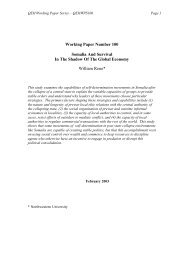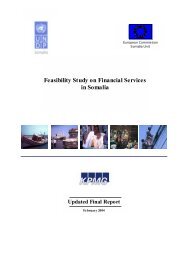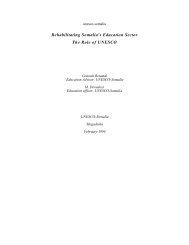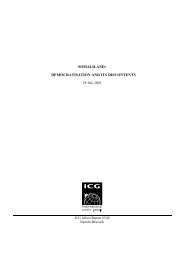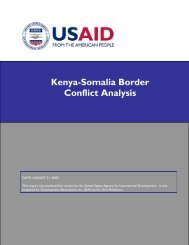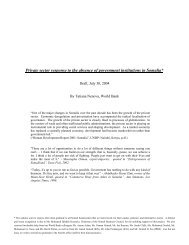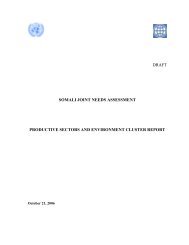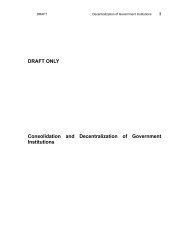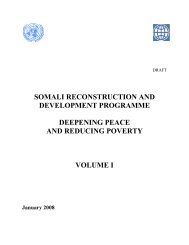Primary Education Survey Evaluation Report Somalia - Somali - JNA
Primary Education Survey Evaluation Report Somalia - Somali - JNA
Primary Education Survey Evaluation Report Somalia - Somali - JNA
Create successful ePaper yourself
Turn your PDF publications into a flip-book with our unique Google optimized e-Paper software.
PES <strong>Evaluation</strong> <strong>Report</strong>, 2008<br />
• To assess the degree to which training of MoE officials in data collection and management<br />
have been successfully and appropriately implemented<br />
• To assess the utility level of the PES in <strong><strong>Somali</strong>a</strong>, in particular the benefits of its results and<br />
outputs to the intended users<br />
• To identify best practice, innovative interventions and shortcomings in the current process of<br />
planning and implementing the annual survey<br />
• To make recommendations and suggestions on possible improvements related to all aspects<br />
of the routine survey, including, if necessary, ways of increasing levels of participation and<br />
ownership and utility of the survey/data by the MoE authorities and other stakeholders<br />
• To make recommendations with respect to the evolving relationship between the<br />
current/future PES and the nascent EMIS system<br />
CONCEPTUAL FRAMEWORK<br />
The PES as currently conceived has many of the classic attributes of a survey in that it is a set of data<br />
collected by independent enumerators at a single point in time. The data is aggregated centrally, subjected<br />
to some analysis and placed in a single report for distribution. The implementation of the survey on an<br />
annual basis has facilitated trend analysis to be undertaken. However, these annual implementations are a<br />
set of independent events, and not an annual upgrading of a central data base. Importantly, the PES has<br />
not used the common strategy of sampling from the population; rather it is a census that collects data<br />
from all schools in the targeted population. This element, along with the centralised aggregation of data,<br />
is a feature that the PES has in common with an EMIS. However, an EMIS has some important features<br />
that distinguish it from a survey. A full description of an EMIS is set out in Appendix 3. Here, a brief<br />
extract from that appendix is presented to define what is understood to be an EMIS in this report.<br />
To clarify understanding about what an EMIS is, and how it can be of assistance in developing an<br />
education infrastructure, the definition and conceptual framework of an EMIS has been adapted from the<br />
work undertaken by UNESCO (1998 Bangkok). This conceptualization defines an EMIS to be ‘an<br />
organized group of information and documentation services that collects, stores, processes, analyses and<br />
disseminates information for educational planning and management” (p.2). As such it is more than a data<br />
storage system. Rather it integrates system components of inputs, processes, outputs and reporting in such<br />
a way that accuracy, flexibility and adaptability, and efficiency are maximized. The elements that need to<br />
be integrated are the:<br />
• Needs of data producers and users<br />
• Data<br />
• Information handling<br />
• Storage of data<br />
• Retrieval of data<br />
• Data analysis<br />
• Computer and manual procedures<br />
• Networking among EMIS centers (UNESCO 1998, p. 4)<br />
It also has a dynamic process orientation that focuses on the two-way flow of information so that all<br />
levels of the organization can make effective use of the data and reports generated from the data. This<br />
flow of information needs to be efficient by avoiding duplication of effort, made accurate by<br />
incorporating validation procedures and adequate training of personnel at all levels, and meeting the<br />
needs of all stakeholders in the system. This complex interaction of components is represented in Figure 1<br />
and has been adapted from the UNESCO (1998) report to reflect some aspects of the <strong><strong>Somali</strong>a</strong> context.<br />
These ideas are more fully developed in Appendix 3.<br />
10



